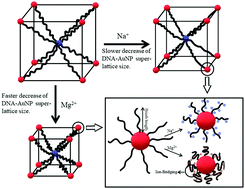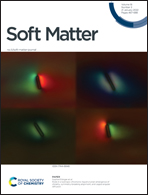Effect of mono- and multi-valent ionic environments on the in-lattice nanoparticle-grafted single-stranded DNA†
Abstract
Polyelectrolyte (PE) chains respond in a complex manner to multivalent salt environments, and this behavior depends on pH, temperature, and the presence of specific counter ions. Although much work has been done to understand the behaviour of free PE chains, it is important to reveal their behaviour on a nanoparticle's surface, where surface constraints, particle geometry, and multi-chain environment can affect their behaviour and contribute to particles’ assembly states. Our work investigates, using in situ small-angle X-ray scattering (SAXS), the morphology of PE (single-stranded DNA) chains grafted onto the surface of spherical gold nanoparticles assembled in a lattice in the presence of monovalent, divalent and trivalent salts. For divalent salts, the DNA brush length was found to decrease at a faster rate with salt concentration than in the monovalent salt environment, while trivalent salts led to chain collapse. Using a power law analysis and the modified Daoud–Cotton model, we have obtained insight into the mechanism of a nanoparticle-grafted chain's response to ionic environments. Our analysis suggests that the decrease in brush length is due to the conventional electrostatic screening for monovalent systems, whereas for divalent systems both electrostatic screening and divalent ion bridging must be considered.



 Please wait while we load your content...
Please wait while we load your content...